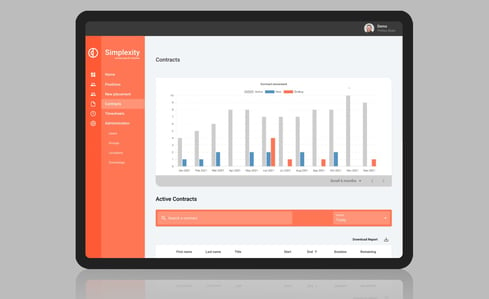Preparing and completing contracts is usually not fun.. unless you’re a lawyer. However, getting your contracts in order is critical to ensuring a smooth process for everyone and a positive relationship with your end client and contractors.
A contract is a legally binding agreement that details the worker’s assigned role, obligations, and hourly or daily pay rate and is one of the most important aspects to get right in your business.
As an outsourced contractor management provider, we’ve been supporting recruiters to manage and pay contractors for many years, and we’ve identified these 7 common and costly mistakes recruiters should avoid when completing contracts.
1. Not stating if the contract rate includes GST in the agreement
This one is actually more common than you might think.
If a contractor is engaged under their own limited company (Pty Ltd) and the contractor’s rate doesn’t state +GST, it can be assumed that the rate is inclusive of GST. This means that when they are payrolled, a further 10% gets deducted from the contractor’s pay. The best practice is to always clearly state the rate + GST.
Likewise, it is important to ensure the invoice rate on your agreement with your end clients stipulates that it is + GST. At Oncore we issue invoices on your behalf so we’ll match the invoice rate to your agreement.
2. Workers on PAYG arrangement not stating super in their rate
For contractors under a PAYG (Pay as You Go) arrangement, be sure to check if the proposed rate is inclusive of Super. It makes a significant difference to a contractor’s take-home pay if the Super is already included within the rate stated.
Workers are eligible for salary packaging and can claim expenses, which will bring down their rate and therefore their super calculation.
In your PAYG contracts, you must stipulate whether the rate is inclusive or exclusive of superannuation.
3. An incorrect entity or ABN entered on the contract
It’s imperative to check that the entity and ABN number on a contract is clear and correct.
Mistakes can happen by simple human error or by addressing the wrong ABN, especially where a client company has a number of ABNs. A quick check with your end client can confirm the entity and ABN they wish to be invoiced under the agreement.
This is important as any mistake on a contract could result in a client rejecting or delaying their payment of an invoice.
4. Incorrect or mismatched start and end dates on contracts
It’s important to always ensure that the agreed start and end dates match on both the client and the contractor’s contract so there are no costly mistakes. Sometimes, the agreed dates change as contracts are pushed forward or backwards, so any time this happens, always make sure it is reflected in the contract.
This also protects everyone involved in the unlikely event of an insurance claim or similar, because there is a clear indication of when the contractor is officially engaged.
5. Partially or unsigned contracts
Simply put, a contract is binding when signed by all parties. An unsigned or partially signed contract may make the contract unenforceable
Not having a complete and signed contract can also result in misunderstandings and disagreements over terms and invoice payments. It is important to ensure all pages have been read and signed where necessary, so all parties are clear on what they have agreed to.
6. Incorrect engagement of contractors as PAYG or Pty Ltd contractors
It is important to ensure it’s clear whether the contractors are working under a PAYG or a PTY contract when submitting all the paperwork. The pay for each engagement is managed very differently and so any confusion could mean delays not only in onboarding the contractor correctly but in payments.
PAYG is short for Pay As You Go and if you were looking to engage sole traders in a labour hire arrangement, they fall into this category – their pay takes into account super and tax. (Tax legislation requires taxes to be withheld where the sole trader is engaged in a labour hire arrangement). https://www.ato.gov.au/business/payg-withholding/payments-you-need-to-withhold-from/labour-hire-firms-and-their-workers/
Pty Ltd means they are working under their own Proprietary Limited company.
For those who work for themselves, ensure you check if the worker is under a Pty Ltd structure or if they actually operate as a sole trader. In the interest of mitigating risk, Oncore does not engage sole traders and will consult with you as to whether they intended to operate under a Pty Ltd structure. It also helps to ask whether they have insurance and if so, the levels of insurance coverage.
It’s always best to ask the questions than to assume as some workers will have a preference for how they engage.
7. Check that all information on your contracts match any other documentation
For any enquiry that may arise from the engagement of a contractor, you will be referring back to the information in your signed contracts. So making sure these are agreed and correct is critical.
Once you have done this, it’s equally important to ensure the information like rates and dates match any other forms or documentation you may be required to complete. This will help you avoid delays to the worker being onboarded by either Oncore or your end client.
At Oncore, we’re always here to help so if you need anything to be clarified, reach out to our support team or jump onto our support site with a helpful list of FAQs.
We also have a library of up to date templates for our clients to utilise and these can be accessed by contacting our support team. We suggest reviewing these to ensure they are relevant and applicable to your specific agreement before using them.
It’s also a good idea to seek the advice of your lawyer to look over your contracts particularly if you are starting out. Any questions? Feel free to reach out to our team.












_11zon%20(1).jpg?width=302&height=124&name=linkedin-sales-solutions-vqWWOnA6--M-unsplash%20(2)_11zon%20(1).jpg)






